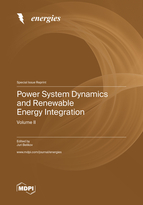Power System Dynamics and Renewable Energy Integration
A special issue of Energies (ISSN 1996-1073). This special issue belongs to the section "F2: Distributed Energy System".
Deadline for manuscript submissions: closed (31 October 2022) | Viewed by 111536
Special Issue Editor
Interests: nonlinear control systems; power systems; renewable energy; computational intelligence
Special Issues, Collections and Topics in MDPI journals
Special Issue Information
Dear Colleagues,
Currently, it is widely accepted that a major barrier toward the massive integration of renewable energy sources is the complex dynamic behavior of large-scale power systems. In many cases, the need to preserve system reliability and stability is a bottleneck, which practically prevents the use of such sources, despite their positive environmental impact and low cost. In addition, power systems with a high penetration level of renewable energy sources will have different topologies, control methods, and management strategies.
This Special Issue will focus on power system dynamics in the light of the large-scale integration of renewable energy sources. We invite papers on innovative technical developments, reviews, case studies, and theoretical papers from different disciplines, which are relevant to dynamics of power systems and the integration of renewable energy sources.
Prof. Dr. Juri Belikov
Guest Editor
Manuscript Submission Information
Manuscripts should be submitted online at www.mdpi.com by registering and logging in to this website. Once you are registered, click here to go to the submission form. Manuscripts can be submitted until the deadline. All submissions that pass pre-check are peer-reviewed. Accepted papers will be published continuously in the journal (as soon as accepted) and will be listed together on the special issue website. Research articles, review articles as well as short communications are invited. For planned papers, a title and short abstract (about 100 words) can be sent to the Editorial Office for announcement on this website.
Submitted manuscripts should not have been published previously, nor be under consideration for publication elsewhere (except conference proceedings papers). All manuscripts are thoroughly refereed through a single-blind peer-review process. A guide for authors and other relevant information for submission of manuscripts is available on the Instructions for Authors page. Energies is an international peer-reviewed open access semimonthly journal published by MDPI.
Please visit the Instructions for Authors page before submitting a manuscript. The Article Processing Charge (APC) for publication in this open access journal is 2600 CHF (Swiss Francs). Submitted papers should be well formatted and use good English. Authors may use MDPI's English editing service prior to publication or during author revisions.
Keywords
- power systems
- dynamic behavior of power systems
- next generation renewable energy technologies
- fundamental limits
- novel energy storage solutions






